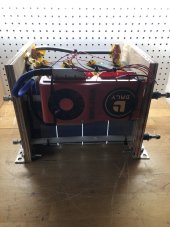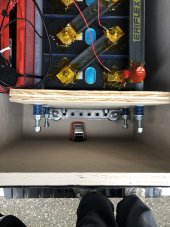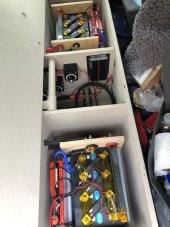Islander_00
New Member
Hello all,
I am refitting my sailboat (Moody 376) with all new DC & AC systems.
Last summer I ordered 8x LF280N cells to build a 24V (8s1p) battery to be used as a main house bank (Victron 24V Multiplus II 3KVA, DC-DC charger - all other systems on board will remain @12V).
As work got in the way, I used the multiplus on a different project and so I now only have the Cells which are brand new (1 Cycle for testing).
As I am now revisiting the sailboat project, It got in my head to switch to a 48V system as I will be looking into electrical propulsion sometime in the future (e.g. an epropulsion 48V 6KW installed in the back for maneuvering/motor sailing... or maybe two of them... but that is a conversation for another time).
I have quotes from reliable vendors through alibaba for LF280N/K cells which will take 2-3 months to arrive to Greece.
I also have a quote for LF280K cells that should be available in EU Warehouse in a few weeks so I could be getting them by the end of the month.
Also note that I have decided to split the cells in 4 custom battery boxes (4s1p) for easier handling. Each box will have a 9p waterproof connector for balancing leads and two posts (or 175A Anderson connectors or both... haven't decided yet) for main (-) & (+). Each series connection between the boxes will be by thick 75mm cable.
The BMS will be placed externaly (maybe in its own box?) and I am looking at the JK BMS which should talk to the Inverter - a 48V Multiplus II 3KVA unit.
so to put it in perspective:
Main Positive (+) ----| BAT_Box1 4s1p LF280N |--| BAT_Box2 4s1p LF280N |--| BAT_Box3 4s1p LF280K|--| BAT_Box4 4s1p LF280K|----JK BMS---- (-) Main Negative
Question is... should I mix 8xLF280N with 8xLF280K in series for 48V???
It will save about 1000$ at this time..
Thoughts on the above?
P.S. - Sorry for the long post...
I am refitting my sailboat (Moody 376) with all new DC & AC systems.
Last summer I ordered 8x LF280N cells to build a 24V (8s1p) battery to be used as a main house bank (Victron 24V Multiplus II 3KVA, DC-DC charger - all other systems on board will remain @12V).
As work got in the way, I used the multiplus on a different project and so I now only have the Cells which are brand new (1 Cycle for testing).
As I am now revisiting the sailboat project, It got in my head to switch to a 48V system as I will be looking into electrical propulsion sometime in the future (e.g. an epropulsion 48V 6KW installed in the back for maneuvering/motor sailing... or maybe two of them... but that is a conversation for another time).
I have quotes from reliable vendors through alibaba for LF280N/K cells which will take 2-3 months to arrive to Greece.
I also have a quote for LF280K cells that should be available in EU Warehouse in a few weeks so I could be getting them by the end of the month.
Also note that I have decided to split the cells in 4 custom battery boxes (4s1p) for easier handling. Each box will have a 9p waterproof connector for balancing leads and two posts (or 175A Anderson connectors or both... haven't decided yet) for main (-) & (+). Each series connection between the boxes will be by thick 75mm cable.
The BMS will be placed externaly (maybe in its own box?) and I am looking at the JK BMS which should talk to the Inverter - a 48V Multiplus II 3KVA unit.
so to put it in perspective:
Main Positive (+) ----| BAT_Box1 4s1p LF280N |--| BAT_Box2 4s1p LF280N |--| BAT_Box3 4s1p LF280K|--| BAT_Box4 4s1p LF280K|----JK BMS---- (-) Main Negative
Question is... should I mix 8xLF280N with 8xLF280K in series for 48V???
It will save about 1000$ at this time..
Thoughts on the above?
P.S. - Sorry for the long post...











